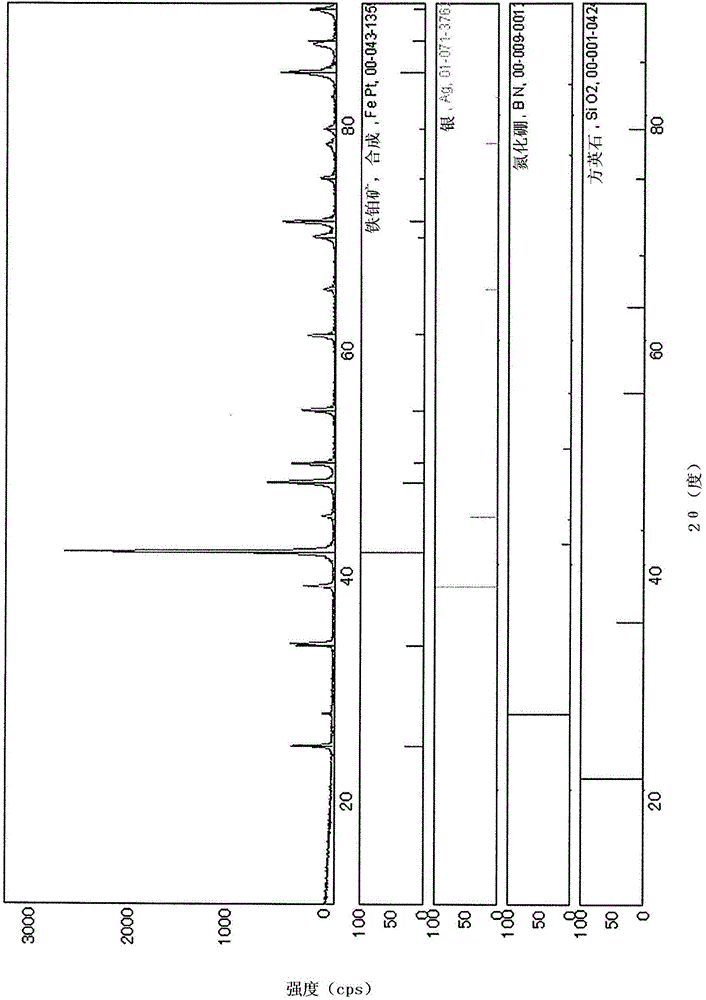Sintered Fe-Pt-based magnetic material
A technology of magnetic materials and non-magnetic materials, applied in the direction of magnetic objects, magnetic thin films, coated with magnetic layers, etc., can solve the problems of fragmentation yield, difficulty in manufacturing high-density sintered bodies, low density, etc., to reduce powder particles volume effect
- Summary
- Abstract
- Description
- Claims
- Application Information
AI Technical Summary
Problems solved by technology
Method used
Image
Examples
Embodiment 1
[0059] Prepare Fe powder, Pt powder, Ag powder, SiO 2 powder, BN powder as raw material powder. These powders were weighed to obtain 65(50Fe-45Pt-5Ag)-5SiO 2 -30BN (mol%).
[0060] Next, the weighed powder was put into a media agitation mill with a capacity of 5 L together with zirconia balls as a grinding medium, and rotated for 2 hours (300 rpm) for mixing and grinding. Then, the mixed powder taken out from the media agitated mill was filled into a carbon mold and hot-pressed.
[0061] The hot pressing conditions were a vacuum atmosphere, a heating rate of 300° C. / hour, a holding temperature of 950° C., a holding time of 2 hours, and pressurization at 30 MPa from the start of heating to the end of holding. Cool naturally in the cavity directly after holding.
[0062] Next, hot isostatic pressing is performed on the sintered body taken out from the mold of the hot press. The conditions of the hot isostatic pressing process were a heating rate of 300°C / hour, a holding tem...
Embodiment 2
[0075]Prepare Fe powder, Pt powder, SiO 2 powder, BN powder as raw material powder. Weigh these powders to get 70(50Fe-50Pt)-5SiO 2 -25BN (mol%).
[0076] Next, the weighed powder was put into a media agitation mill with a capacity of 5 L together with zirconia balls as a grinding medium, and rotated for 2 hours (300 rpm) for mixing and grinding. Then, the mixed powder taken out from the media agitated mill was filled into a carbon mold and hot-pressed.
[0077] The hot-pressing conditions were the same as in Example 1, a vacuum atmosphere, a heating rate of 300° C. / hour, a holding temperature of 950° C., a holding time of 2 hours, and pressurization at 30 MPa from the start of heating to the end of holding. Cool naturally in the cavity directly after holding.
[0078] Next, hot isostatic pressing is performed on the sintered body taken out from the mold of the hot press. The conditions of the hot isostatic pressing process are the same as in Example 1. The heating rate i...
Embodiment 3
[0090] Prepare Fe powder, Pt powder, Cu powder, SiO 2 powder, BN powder, TiO 2 Powder and MgO powder are used as raw material powder. These powders were weighed to obtain 73(30Fe-60Pt-10Cu)-5SiO 2 -20BN-1TiO 2 -1 MgO (mol %).
[0091] Next, the weighed powder was put into a media agitation mill with a capacity of 5 L together with zirconia balls as a grinding medium, and rotated for 2 hours (300 rpm) for mixing and grinding. Then, the mixed powder taken out from the media agitated mill was filled into a carbon mold and hot-pressed.
[0092] The conditions of the hot pressing were the same as in Example 1, a vacuum atmosphere, a heating rate of 300° C. / hour, a holding temperature of 1060° C., a holding time of 2 hours, and pressurization at 30 MPa from the start of heating to the end of holding. Cool naturally in the cavity directly after holding.
[0093] Next, hot isostatic pressing is performed on the sintered body taken out from the mold of the hot press. The conditi...
PUM
| Property | Measurement | Unit |
|---|---|---|
| particle diameter | aaaaa | aaaaa |
Abstract
Description
Claims
Application Information
 Login to View More
Login to View More - R&D Engineer
- R&D Manager
- IP Professional
- Industry Leading Data Capabilities
- Powerful AI technology
- Patent DNA Extraction
Browse by: Latest US Patents, China's latest patents, Technical Efficacy Thesaurus, Application Domain, Technology Topic, Popular Technical Reports.
© 2024 PatSnap. All rights reserved.Legal|Privacy policy|Modern Slavery Act Transparency Statement|Sitemap|About US| Contact US: help@patsnap.com










